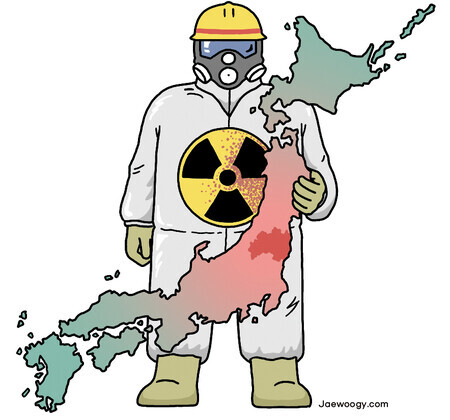hankyoreh
Links to other country sites 다른 나라 사이트 링크
[Column] Fukushima disaster through eyes of subcontractor workers

In 2013, Minoru Ikeda reached the mandatory retirement age as a postal worker. The next year, he moved to Fukushima, where he worked for more than a year at a third-tier subcontractor for Tokyo Electric Power Company (TEPCO). The company assigned him to clean up pollution at Fukushima Daiichi and the surrounding areas.
Ikeda’s 43 years in mail delivery hadn’t prepared him at all for what he would find at Fukushima. When he left Fukushima, he was no longer the person he’d been a year before. Afterward, he wrote a book about his experiences called “Diary of Work for a Fukushima Subcontractor” and became an activist opposing nuclear power.
When he set out for Fukushima, he’d been motivated partly with the hope of helping Japan recover from the accident at Fukushima and partly with the hope of making some money. In Fukushima, his hopes came true – but only in part.
Ikeda did do work that was needed to make Fukushima inhabitable again. And the subcontractor did pay his wages each month, calculated on an hourly basis. But his worksite was governed not by science but by rule of thumb, and the pay owed to the subcontractor workers risking radiation exposure was siphoned off by invisible hands at multiple stages.
The training that Ikeda and his coworkers received before being put to work was over in a matter of hours. But even if they’d been trained more thoroughly, what was actually needed on the job was something entirely different.
They couldn’t completely remove the radiation, which was invisible. Nor could they remove the forests and fields and the nuclear reactors themselves. The goal of the cleanup seemed to be only clearing away what was within reach and moving it out of sight.
Furthermore, all they could do was stack up the scattered objects into huge piles, since — rather like spent nuclear fuel — no further disposal was possible.
TEPCO staff were hardly ever seen on the worksite. But the “invisible men” were not the TEPCO staff but the subcontractor workers themselves.
“From the perspective of the workers on the ground, TEPCO employees were like Taoist immortals hovering above the clouds,” Ikeda said. Indeed, the TEPCO staff paid little attention to either the situation on the ground or the workers themselves. These “invisible men” were at risk of injury, or even death, on the job.
Ikeda described the workers in their white protective gear as “termites fighting against a giant” and rhetorically asked, “exactly how many millions of workers would be needed over the next 50 years?”
Without the workers at subcontractors, a nuclear plant can’t be operated or even shut down. The “outsourcing of risk” is a fundamental and unchangeable constant in the nuclear power industry.
The night the old subcontractor worker returned to Tokyo, he was shocked to see the garish lights of the city, which had once been illuminated by electricity flowing from Fukushima. Nuclear power even makes possible the outsourcing of space.
To ensure the same thing doesn’t happen to the city lights of Seoul, we need to take seriously the tragedy of Fukushima, which happened ten years ago.
By Ahn Young-choon, editorial writer
Please direct comments or questions to [english@hani.co.kr]

Editorial・opinion
![[Editorial] Penalties for airing allegations against Korea’s first lady endanger free press [Editorial] Penalties for airing allegations against Korea’s first lady endanger free press](https://flexible.img.hani.co.kr/flexible/normal/500/300/imgdb/original/2024/0502/1817146398095106.jpg) [Editorial] Penalties for airing allegations against Korea’s first lady endanger free press
[Editorial] Penalties for airing allegations against Korea’s first lady endanger free press![[Editorial] Yoon must halt procurement of SM-3 interceptor missiles [Editorial] Yoon must halt procurement of SM-3 interceptor missiles](https://flexible.img.hani.co.kr/flexible/normal/500/300/imgdb/child/2024/0501/17145495551605_1717145495195344.jpg) [Editorial] Yoon must halt procurement of SM-3 interceptor missiles
[Editorial] Yoon must halt procurement of SM-3 interceptor missiles- [Guest essay] Maybe Korea’s rapid population decline is an opportunity, not a crisis
- [Column] Can Yoon steer diplomacy with Russia, China back on track?
- [Column] Season 2 of special prosecutor probe may be coming to Korea soon
- [Column] Park Geun-hye déjà vu in Yoon Suk-yeol
- [Editorial] New weight of N. Korea’s nuclear threats makes dialogue all the more urgent
- [Guest essay] The real reason Korea’s new right wants to dub Rhee a founding father
- [Column] ‘Choson’: Is it time we start referring to N. Korea in its own terms?
- [Editorial] Japan’s rewriting of history with Korea has gone too far
Most viewed articles
- 1Months and months of overdue wages are pushing migrant workers in Korea into debt
- 2[Editorial] Penalties for airing allegations against Korea’s first lady endanger free press
- 3Trump asks why US would defend Korea, hints at hiking Seoul’s defense cost burden
- 4Bills for Itaewon crush inquiry, special counsel probe into Marine’s death pass National Assembly
- 560% of young Koreans see no need to have kids after marriage
- 6Korean firms cut costs, work overtime amid global economic uncertainties
- 7[Guest essay] Maybe Korea’s rapid population decline is an opportunity, not a crisis
- 81 in 3 S. Korean security experts support nuclear armament, CSIS finds
- 9S. Korea discusses participation in defense development with AUKUS alliance
- 10[Reporter’s notebook] In Min’s world, she’s the artist — and NewJeans is her art